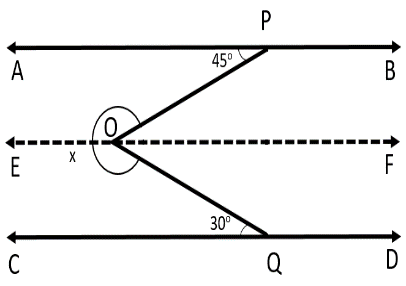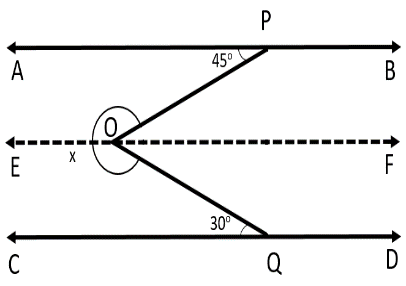
In the adjoining figure, find the value of x.


Answer
513.4k+ views
Hint: Here there are two transversals OP and OQ. For a transversal passing through two parallel lines the alternate interior angles are equal. With this property we will get the angles $\angle POF$ and $\angle QOF$. Now, by the full angle concept we can find the angle x.
Complete step-by-step solution -

Here, we have to find the value of x.
We are given that $\angle APO={{45}^{\circ }}$ and $\angle CQO={{30}^{\circ }}$.
Here we have three parallel lines AB, EF and CD. i.e.
$AB\parallel EF\parallel CD$
There are two transversals OP and PQ.
We know that a transversal is a line that cuts two or more parallel lines at two distinct points.
Here, OP is the transversal corresponding to the parallel lines AB and EF.
OQ is the transversal corresponding to the parallel lines EF and CD.
Since, OP is the transversal, we can say that the alternate interior angles are equal. Therefore, we can write:
$\angle APO=\angle POF={{45}^{\circ }}$
Similarly, for the transversal OQ the alternate interior angles are equal. Hence, we get:
$\angle CQO=\angle QOF={{30}^{\circ }}$
Here, x, $\angle POF$ and $\angle QOF$ form a full angle.
That is, a full angle is an angle whose measure is exactly ${{360}^{\circ }}$ which is a full circle.
Hence, we will get:
$x+\angle POF+\angle QOF={{360}^{\circ }}$
By substituting the values of $\angle POF$ and $\angle QOF$, we obtain:
$\begin{align}
& x+{{45}^{\circ }}+{{30}^{\circ }}={{360}^{\circ }} \\
& x+{{75}^{\circ }}={{360}^{\circ }} \\
\end{align}$
Now, by taking ${{75}^{\circ }}$ to the right side, ${{75}^{\circ }}$ becomes $-{{75}^{\circ }}$. Hence we obtain:
$\begin{align}
& x={{360}^{\circ }}-{{75}^{\circ }} \\
& x={{285}^{\circ }} \\
\end{align}$
Therefore the value of $x$ is ${{285}^{\circ }}$.
Note: Here, you can find in other way by splitting the angle x into $\angle POE$ and $\angle QOE$ which you can find with the help of its alternate exterior angles $\angle BPO$ and $\angle DQO$, where they forms a linear pair with $\angle APO$ and $\angle CQO$.
Complete step-by-step solution -

Here, we have to find the value of x.
We are given that $\angle APO={{45}^{\circ }}$ and $\angle CQO={{30}^{\circ }}$.
Here we have three parallel lines AB, EF and CD. i.e.
$AB\parallel EF\parallel CD$
There are two transversals OP and PQ.
We know that a transversal is a line that cuts two or more parallel lines at two distinct points.
Here, OP is the transversal corresponding to the parallel lines AB and EF.
OQ is the transversal corresponding to the parallel lines EF and CD.
Since, OP is the transversal, we can say that the alternate interior angles are equal. Therefore, we can write:
$\angle APO=\angle POF={{45}^{\circ }}$
Similarly, for the transversal OQ the alternate interior angles are equal. Hence, we get:
$\angle CQO=\angle QOF={{30}^{\circ }}$
Here, x, $\angle POF$ and $\angle QOF$ form a full angle.
That is, a full angle is an angle whose measure is exactly ${{360}^{\circ }}$ which is a full circle.
Hence, we will get:
$x+\angle POF+\angle QOF={{360}^{\circ }}$
By substituting the values of $\angle POF$ and $\angle QOF$, we obtain:
$\begin{align}
& x+{{45}^{\circ }}+{{30}^{\circ }}={{360}^{\circ }} \\
& x+{{75}^{\circ }}={{360}^{\circ }} \\
\end{align}$
Now, by taking ${{75}^{\circ }}$ to the right side, ${{75}^{\circ }}$ becomes $-{{75}^{\circ }}$. Hence we obtain:
$\begin{align}
& x={{360}^{\circ }}-{{75}^{\circ }} \\
& x={{285}^{\circ }} \\
\end{align}$
Therefore the value of $x$ is ${{285}^{\circ }}$.
Note: Here, you can find in other way by splitting the angle x into $\angle POE$ and $\angle QOE$ which you can find with the help of its alternate exterior angles $\angle BPO$ and $\angle DQO$, where they forms a linear pair with $\angle APO$ and $\angle CQO$.
Recently Updated Pages
Master Class 9 Social Science: Engaging Questions & Answers for Success

Master Class 9 Science: Engaging Questions & Answers for Success

Master Class 9 English: Engaging Questions & Answers for Success

Master Class 9 Maths: Engaging Questions & Answers for Success

Master Class 9 General Knowledge: Engaging Questions & Answers for Success

Class 9 Question and Answer - Your Ultimate Solutions Guide

Trending doubts
Which places in India experience sunrise first and class 9 social science CBSE

Fill the blanks with the suitable prepositions 1 The class 9 english CBSE

Write the 6 fundamental rights of India and explain in detail

Difference Between Plant Cell and Animal Cell

What is pollution? How many types of pollution? Define it

What is the Full Form of ISI and RAW




